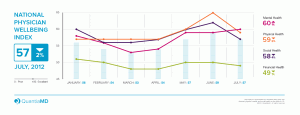Physicians’ wellbeing dropped in July: while providers’ mental health stayed sound since June, it’s financial, physical and social health that’s dragging providers’ overall wellness down.
QuantiaMD, the social network exclusively for doctors, launched the Physician Wellbeing Index in January 2012. The Index measures four aspects of physician-reported wellbeing: physical, mental, financial, and social health. QuantiaMD says it’s the world’s only measure of “how physicians are doing as people.” Based on the Index, QuantiaMD tailors content to meet the needs of the physicians in the social network.
 In July, the chart illustrates that doctors’ wellbeing slipped in 3 of the 4 areas. Surprisingly, mental health edged up slightly at 1%, while physical health declined by 6%, social health by 4%, and financial health by 1%
In July, the chart illustrates that doctors’ wellbeing slipped in 3 of the 4 areas. Surprisingly, mental health edged up slightly at 1%, while physical health declined by 6%, social health by 4%, and financial health by 1%
26% of primary care physicians (PCPs) reported poor financial health to QuantiaMD. Among those doctors feeling negative financial pressure, 81% report that profits fell from 2011 and 43% have trouble covering costs. Declining reimbursement is the main reason, cited by 80%. Increasing practice costs are another driver of financial ills, cited by 71%.
49% of PCPs have not had a salary increase in over a year; 18% have seen cuts in their salaries.
Health Populi’s Hot Points: QuantiaMD’s topline take on the July 2012 data is that the decline in PCPs’ wellbeing is bad news for the implementation of the Affordable Care Act, which intends to bolster access to primary care for newly-insured American health citizens.
Why is this the case? Because as PCPs face declining reimbursement, increasing operating costs, and eroding quality of life, medical students won’t choose to enter primary care, and already-practicing PCPs will be inclined to leave the profession. Many are taking jobs in hospital administration, some going into non-clinical teaching positions, and others in non-clinical administrative job. Prospects for the already-diminished PCP supply look dimmer in light of these statistics.
A survey published by Jackson Healthcare in July 2012 found that one-third of physicians overall is looking to retire in the next decade. Un-wellbeing, indeed.
Of those physicians surveyed by Jackson, 84% said they’d continue to practice medicine through 2013 – meaning that 16% don’t plan to, instead choosing part-time, retirement, or departure from medicine. Those planning to leave the profession in the next 10 years are likely general surgeons, family practitioners, emergency medicine doctors, and OB/GYNs, according to the survey.
Of those doctors staying in practice, huge numbers do not plan to accept new Medicare patients including 76% of OB/GYNs, 75% of family practitioners, 73% of internists, and 57% of psychiatrists.
A telling piece of data is that most physicians do not use physician assistance or nurse practitioners — professionals who can help “extend” physicians to care for more patients in a team-based environment. This approach is called-for in health reform because it rationally expands primary care capacity, allowing physicians to operate at the highest and best use — in other words, to see patients who most need their hands-on care.
QuantiaMD and Jackson Healthcare point to the sobering reality facing the U.S.: that the nation is under-served in primary care, which, in other developed countries, is the infrastructure that boosts health outcomes.




 Interviewed live on BNN Bloomberg (Canada) on the market for GLP-1 drugs for weight loss and their impact on both the health care system and consumer goods and services -- notably, food, nutrition, retail health, gyms, and other sectors.
Interviewed live on BNN Bloomberg (Canada) on the market for GLP-1 drugs for weight loss and their impact on both the health care system and consumer goods and services -- notably, food, nutrition, retail health, gyms, and other sectors. Thank you, Feedspot, for
Thank you, Feedspot, for  As you may know, I have been splitting work- and living-time between the U.S. and the E.U., most recently living in and working from Brussels. In the month of September 2024, I'll be splitting time between London and other parts of the U.K., and Italy where I'll be working with clients on consumer health, self-care and home care focused on food-as-medicine, digital health, business and scenario planning for the future...
As you may know, I have been splitting work- and living-time between the U.S. and the E.U., most recently living in and working from Brussels. In the month of September 2024, I'll be splitting time between London and other parts of the U.K., and Italy where I'll be working with clients on consumer health, self-care and home care focused on food-as-medicine, digital health, business and scenario planning for the future...